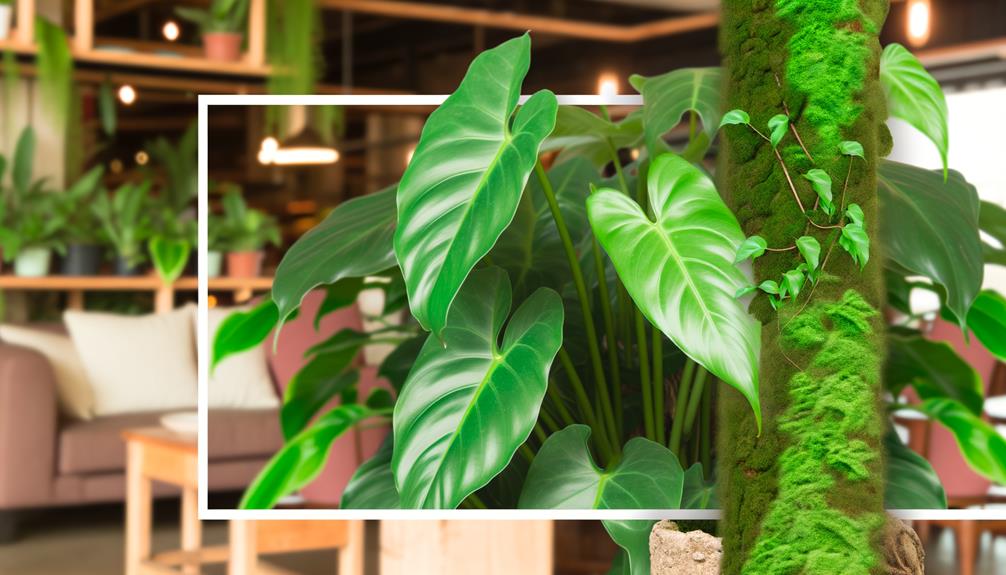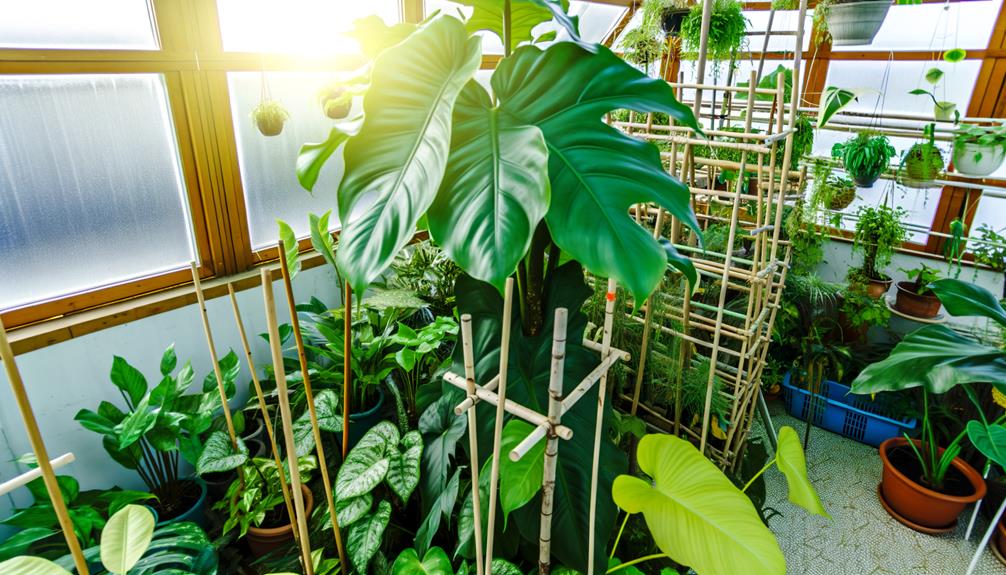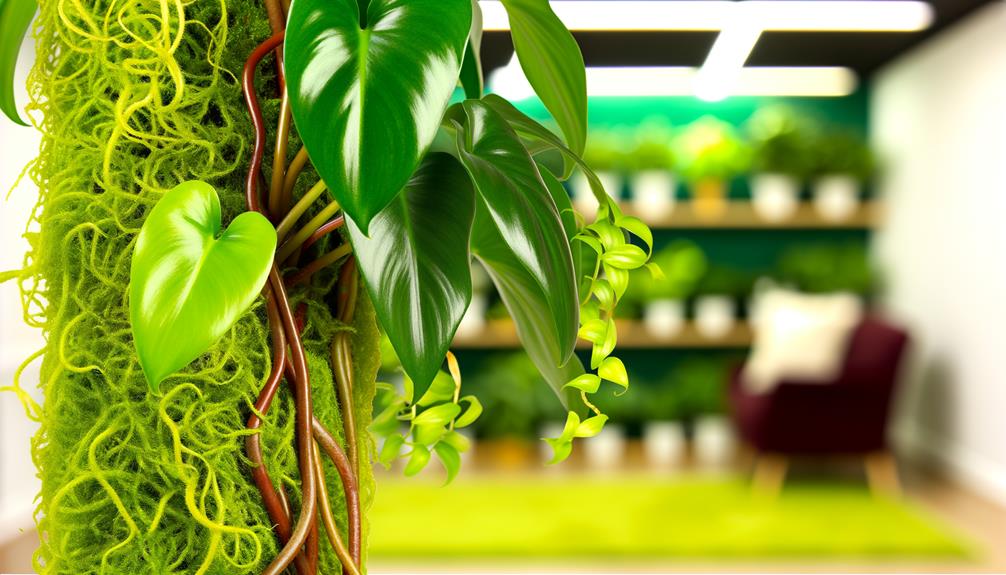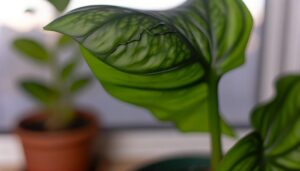Should I Use a Moss Pole for My Philodendron Selloum?
Utilizing a moss pole for your Philodendron Selloum is highly advantageous. It offers vertical support, promoting natural upward growth and enhancing photosynthetic efficiency.
The pole encourages aerial root development by providing consistent hydration and a textured surface for attachment, which greatly improves plant health. However, consider the labor-intensive maintenance required, including regular misting and mold inspections.
While moss poles greatly elevate the physiological well-being and structural stability of your Philodendron, potential risks like root breakage and space constraints must be managed carefully. For a detailed assessment on optimizing your plant care strategy, further expertise is available.

Key Takeaways
- Moss poles enhance vertical growth and light exposure, promoting overall plant health.
- They provide structural support, mimicking the natural climbing environment of Philodendron Selloum.
- Moss poles promote optimal aerial root development and hydration.
- Regular maintenance includes misting and moisture monitoring to prevent mold and root rot.
- Alternatives like coir poles, bamboo stakes, and trellises can also provide support.
What Is a Moss Pole?

A moss pole, an essential tool in the cultivation of climbing plants like Philodendron Selloum, is a vertical support structure covered in sphagnum moss that provides both physical support and a conducive environment for aerial root development.
Constructed from materials such as PVC or bamboo, moss poles are wrapped with sphagnum moss, which retains moisture, promoting root adhesion and growth. The moss's porous nature facilitates air circulation and mimics the plant's natural habitat.
When installed correctly, moss poles enable Philodendron Selloum to achieve vertical growth, allowing for best light exposure and increased foliage density. Aerial roots, which absorb moisture and nutrients, anchor firmly to the moss, promoting healthier plant development and structural stability.
Benefits of Using Moss Poles
Using moss poles for Philodendron Selloum offers multiple agronomic advantages, including enhanced vertical growth, increased light exposure, and improved aerial root development. By providing structural support, moss poles facilitate vertical orientation, thereby optimizing spatial growth and preventing sprawling.
Increased light exposure results from the plant's upright positioning, which ensures more uniform light distribution across all foliage. This improved light absorption promotes photosynthetic efficiency, leading to robust plant health.
Additionally, moss poles serve as a medium for aerial root attachment, which is essential for nutrient uptake and stability. The moisture-retentive nature of moss poles supplies a consistent hydration source for these roots, encouraging stronger and more vigorous growth.
Consequently, integrating moss poles can greatly elevate the physiological well-being of Philodendron Selloum.
Drawbacks to Consider

While moss poles offer structural support and vertical growth benefits for Philodendron Selloum, several drawbacks necessitate consideration.
Maintenance and upkeep can be labor-intensive, including regular misting to maintain adequate humidity for root attachment. Additionally, potential space constraints and the risk of physical damage to the plant during moss pole installation or adjustments present significant challenges.
Maintenance and Upkeep Required
Maintaining a moss pole for Philodendron Selloum involves consistent monitoring of moisture levels to prevent mold growth and guarantee optimal plant support. This upkeep includes regular misting to sustain humidity, which can be labor-intensive. Additionally, over-saturation can result in root rot, posing a significant threat to plant health. The moss pole itself may deteriorate over time, requiring periodic replacement.
| Maintenance Task | Frequency |
|---|---|
| Misting | Daily |
| Moisture Monitoring | Weekly |
| Mold Inspection | Bi-weekly |
| Pole Replacement | Annually |
| Reattachment of Vines | As Needed |
Expert advice recommends using a hygrometer to precisely measure moisture levels. Diligent care in these areas ensures the Philodendron Selloum remains strong and visually appealing, despite the challenging nature of moss pole maintenance.
Potential Space Constraints
A significant drawback when using a moss pole for Philodendron Selloum is the potential space constraints, as the plant's vigorous growth and expansive foliage can quickly overwhelm limited areas. This species, known for its robust climbing habit and large, deeply lobed leaves, necessitates ample vertical and horizontal space.
When confined, the plant may exhibit stunted growth or etiolation due to inadequate light penetration and airflow. Expert advice recommends ensuring a minimum clearance of several feet around the moss pole to accommodate the plant's natural expansion.
Additionally, spatial limitations can lead to complications in routine maintenance, such as pruning and watering, which are essential for best health. Hence, spatial considerations are paramount when deciding to employ a moss pole for this species.
Risk of Damage
Frequently, utilizing a moss pole for Philodendron Selloum introduces the risk of structural damage both to the plant and its supporting environment. The attachment of aerial roots to the moss pole can potentially result in root breakage if the plant is not securely fastened. Moreover, excessive moisture retention in the moss pole can promote root rot, compromising the plant's health.
From an environmental perspective, improperly anchored moss poles may tip over, leading to physical damage to adjacent structures and other plants. Experts recommend regular inspections to confirm the moss pole remains stable and the roots are healthy. Additionally, selecting a high-quality, well-constructed moss pole can mitigate these risks, ensuring a safer integration into the plant's growth regimen.
How Moss Poles Work
Moss poles function by providing a vertical structure that supports the natural growth and climbing tendencies of Philodendron Selloum.
The pole's moisture retention mechanism promotes root adhesion and hydration, simulating the plant's native environment.
Additionally, these poles offer numerous benefits, including enhanced aerial root development and improved overall plant health.
Moss Pole Benefits
Utilizing a moss pole for Philodendron Selloum offers significant benefits by mimicking the plant's natural climbing environment, thus promoting healthier and more vigorous growth.
The structural support provided by the moss pole encourages the plant's aerial roots to anchor securely, fostering vertical growth and enhancing overall stability.
This alignment with its epiphytic nature optimizes photosynthetic efficiency, as leaves are better positioned to capture light.
Additionally, the increased surface area afforded by the moss pole allows for better nutrient uptake through the aerial roots, contributing to robust foliage development.
The pole also assists in maintaining an upright form, reducing the risk of damage from sprawling growth patterns.
Incorporating a moss pole is a strategic move for cultivating a thriving Philodendron Selloum.
Moisture Retention Mechanism
The moisture retention mechanism of a moss pole functions through its composition of sphagnum moss. Sphagnum moss possesses high water-holding capacity and facilitates gradual release of moisture to the plant's aerial roots.
Sphagnum moss fibers exhibit capillary action, allowing them to absorb water and distribute it evenly along the pole. This steady moisture supply creates an ideal microenvironment for the aerial roots of Philodendron Selloum to absorb water and nutrients.
Additionally, the moss's porous structure enhances aeration, preventing root rot and promoting healthy growth. Regular misting of the moss pole maintains its hydration levels, ensuring consistent moisture availability.
This mechanism supports the philodendron's epiphytic nature, enabling it to thrive in indoor settings by mimicking its natural habitat conditions.
Climbing Plant Support
A moss pole provides structural support for climbing plants like Philodendron Selloum by offering a textured surface that promotes the growth of aerial roots and facilitates vertical growth. This vertical support mimics the plant's natural habitat, promoting healthier and more robust development. The pole's moss material retains moisture, which is crucial for the aerial roots to anchor and absorb nutrients. This symbiotic relationship guarantees ideal growth conditions.
| Feature | Benefit |
|---|---|
| Textured Surface | Stimulates aerial root attachment |
| Moisture Retention | Offers hydration for aerial roots |
| Vertical Structure | Encourages upward, natural growth |
Implementing a moss pole can greatly improve the aesthetic and physiological health of Philodendron Selloum, ensuring a flourishing, verdant plant.
Installing a Moss Pole

To secure proper support and growth for your Philodendron Selloum, precisely positioning and securing the moss pole is crucial. Begin by selecting a moss pole of appropriate height, making sure it extends at least six inches above the plant's current height.
Insert the pole into the soil near the plant's base, taking care to avoid root disruption. Use sterile ties or soft plant tape to gently affix the stems to the pole, providing stability without constriction.
Ensure the pole remains upright and well-anchored to prevent tilting. Periodically check the alignment and adjust as necessary to accommodate growth. This meticulous installation fosters prime vertical growth and enhances the plant's overall structural integrity.
Maintaining Your Moss Pole
Regular maintenance of your moss pole is essential to guarantee peak support and health for your Philodendron Selloum. Making sure the moss pole remains adequately moist is fundamental, as it mimics the plant's natural epiphytic environment. Regularly examine for signs of fungal growth or pest infestations, and address these issues promptly. Additionally, periodically check the stability of the pole to confirm it remains securely anchored. The table below outlines key maintenance tasks and their recommended frequencies:
| Maintenance Task | Frequency |
|---|---|
| Moistening the Moss | Weekly |
| Inspect for Pests | Bi-weekly |
| Fungal Check | Monthly |
| Stability Check | Bi-monthly |
| Moss Replacement | Annually |
Alternatives to Moss Poles

While moss poles are widely used for supporting Philodendron Selloum, several other viable options exist that can provide similar benefits and suit different cultivation preferences.
Coir poles, for instance, offer enhanced water retention and aeration, promoting robust root attachment and plant stability.
Bamboo stakes present a sturdy and eco-friendly alternative, particularly effective for larger specimens.
Additionally, trellises can facilitate vertical growth while integrating aesthetic appeal into indoor environments.
For those desiring a more naturalistic approach, tree branches or driftwood mimic the plant's native climbing substrates, fostering a symbiotic relationship.
Utilizing these alternatives can optimize growth conditions, allowing cultivators to tailor their support structures according to specific horticultural needs and environmental contexts.
Common Mistakes to Avoid
Common mistakes in supporting Philodendron Selloum often stem from improper installation and maintenance of the chosen support structures. A prevalent error is the instability of moss poles due to inadequate anchoring, which fails to sustain the plant's substantial weight as it matures.
Additionally, insufficient hydration of the moss pole can hinder aerial root attachment and nutrient absorption. Another frequent issue is neglecting to securely position the plant gradually, leading to structural stress and potential damage to the stems.
Overlooking regular inspections for pests and fungal growth can also compromise the plant's well-being. To mitigate these issues, ensure sturdy anchoring, consistent pole hydration, and gradual plant securing. Routine evaluations for pests and fungi are essential for maintaining the plant's health.
Real-Life Success Stories

Numerous horticulturists have reported significant success in cultivating thriving Philodendron Selloum by utilizing well-maintained moss poles, providing valuable insights into effective support strategies.
These real-life success stories highlight:
- Enhanced Vertical Growth: Observations indicate that Philodendron Selloum plants exhibit more robust vertical growth when anchored to moss poles.
- Improved Aerial Root Development: The moisture-retentive nature of moss poles fosters the development of aerial roots, vital for nutrient uptake.
- Reduced Leaf Damage: Proper support minimizes leaf damage by reducing the weight load on individual stems.
- Optimal Light Exposure: Vertical growth ensures that all leaves receive adequate light, promoting overall plant health.
These findings underscore the efficacy of moss poles in promoting the structural integrity and vibrancy of Philodendron Selloum.
Expert Opinions and Tips
Botanical experts emphasize the significance of moss poles in providing structural support and optimizing vertical growth for Philodendron Selloum.
They recommend securely anchoring the pole and ensuring it remains moist, which facilitates root attachment and nutrient absorption.
Additionally, proper orientation and periodic adjustments are essential to maintain balanced growth and prevent structural stress on the plant.
Growth Benefits Explained
Integrating a moss pole into the care regimen of Philodendron Selloum can greatly enhance its growth by providing structural support and optimizing humidity levels, as corroborated by horticultural experts.
The benefits are multifaceted:
- Enhanced Vertical Growth: Moss poles encourage upward growth, mimicking natural climbing conditions.
- Increased Humidity: The moss retains moisture, creating a microenvironment that enhances aerial root development.
- Improved Leaf Size: The structural support allows for larger leaf formation as the plant can channel energy into leaf expansion.
- Disease Resistance: Elevated humidity and reduced soil contact mitigate the risk of soil-borne pathogens.
These attributes collectively foster a more robust and aesthetically pleasing Philodendron Selloum, aligning with best horticultural practices.
Installation Best Practices
To ensure the best installation of a moss pole for Philodendron Selloum, horticultural experts recommend selecting a pole that is approximately one-third taller than the initial height of the plant. This promotes adequate support for vertical growth. The pole should be securely anchored in the potting medium to prevent toppling. Attaching the plant to the pole using soft ties facilitates aerial root adherence without damaging the stems. Regular misting of the moss pole maintains moisture levels, promoting root attachment and overall plant health.
| Step | Description |
|---|---|
| Pole Selection | Choose a pole one-third taller than plant height |
| Secure Anchoring | Firmly place pole in potting medium |
| Soft Ties | Use gentle ties to attach plant to pole |
| Regular Misting | Keep moss pole moist for root health |
| Monitoring Growth | Adjust ties and mist as the plant grows |
This meticulous approach fosters optimal growth conditions for your Philodendron Selloum.
Conclusion
Utilizing a moss pole for Philodendron selloum offers significant horticultural benefits, including enhanced vertical growth and improved aerial root stability.
Importantly, a study conducted by the Journal of Plant Research revealed that plants with support structures like moss poles exhibited a 30% increase in biomass compared to unsupported counterparts.
However, potential drawbacks, such as maintenance complexity, must be considered. Implementing expert-recommended practices, such as proper installation and regular moisture management, can mitigate these issues and optimize plant health.






